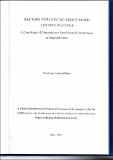Factors Influencing Group Based Lending in Kenya

View/
Date
2015-05Author
Muchena, Loyford Mwiti
Type
ThesisLanguage
enMetadata
Show full item recordAbstract
This study sought to investigate the factors influencing group based lending in Kenya with a special emphasis on Nanyuki town. The study focused on the lenders perspective as opposed to the borrower's perspective. Group based lending has been used the world over for economic empowerment for the poor who lack formal collateral to obtain credit. The main objectives for the study were to test the target market, the economies of scale, the group type or the group cohesiveness and the bank policy as some of the factors influencing group based lending The information or literature on groups was gathered from secondary sources and the primary sources. The theoretical review features various theories about groups and some of the unique group behaviours that contribute to group lending. The theoretical framework follows with details of group features that relate positively to the specific objectives of the study. The empirical review analyses each theory's applicability in group lending. The joint liability theory which identifies group lending as a non-conventional lending technology features prominently. Additionally, the conceptual framework has been constructed to show the dependent variable and the independent variables. The dependent variables are backed by the operational framework which appears in a separate chart. The cperational framework gives an illustration of how the independent variables were measured by the parameters to support the study hypothesis. In chapter three, a descriptive research design was used and a non-probability sample design. ln that respect, a purposive sampling• method was used to collect data. Purposive sampling method uses selective or judgmental techniques to construct a sample. The target population was 72 while the sample size of 30 composed of the credit manager mid two credit officers was selected as respondents. Two credit officers and a manager were selected from 10 organizations that use groups for lending including three others from govemment programs. Questionmires were used owing to their relative ease as opposed to other data collecting methods. The questiounaires were constructed on the Likert Scale seeking the respondents level of agreement from, I strongly disagree to r strongly agree. The data was presented on tables, graphs and figures before analysis using descriptive statistics, with the help of the Statistical Program for Social Sciences (SPSS). Finally, a summary, recommendations and conclusions of the research were made. There are suggestions for further research based on the noted research gaps.
Publisher
KeMU
Description
HG 3754.5 .M83 2015
